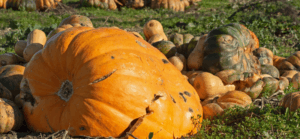HALLOWEEN WASTE: SHOULD LOCAL AUTHORITIES BE SCARED?
Halloween is renowned for spooky costumes, tasty treats and scary decorations, but is it becoming synonymous with waste too? From carved pumpkins to old costumes and decorations, there are many different materials that make up local waste streams after Halloween.
This year we are providing guidance for local authorities on how they can help to reduce the environmental impact of Halloween without sucking the fun out of it!
THE SCOOP ON PUMPKIN WASTE

Pumpkins are a universal symbol of Halloween, but what becomes of the many pumpkins used as decorations in the days and weeks following the celebrations? According to Hubbub, a frightening 15.8 million pumpkins will be thrown away this Halloween. This equates to around 18,000 tonnes of food waste ending up in landfills, decomposing and releasing greenhouse gases such as methane.
With the potential for an increase in waste, some local authorities like Powys County Council and Cotswold District Council are urging residents to be mindful and try to reduce the amount of pumpkin waste they produce.
Luckily, there are many ways to utilise leftover pumpkin. The fruit can be turned into tasty treats like pumpkin pie or soup, and Hubbub has some great recipes to try. Alternatively, composting is a great way to dispose of leftovers and replanting pumpkin seeds is a cost-effective and environmentally friendly way to reduce waste and grow more pumpkins for the following year.
Alfred H Knight supports local authorities through a comprehensive suite of sampling and analytical services. Our experts help councils build an accurate and reliable profile of their local waste streams, allowing them to identify changes in waste-handling behaviours and variations in materials in waste streams and make informed improvements to waste-handling activities and collections.
REMOVING THE MASK ON COSTUME WASTE
In 2017, Hubbub found that around 7 million Halloween costumes were thrown away yearly. This accounts for the generation of an astonishing two thousand tonnes of plastic waste each year. Whilst there are no updated figures on this, it is a scary fact and one that needs rectifying.
Single-use plastics pose several issues to councils. Not only do these persistent materials pollute our water bodies, parks and streets, but authorities are also bound by national and regional regulatory obligations aimed at reducing the amount of plastic waste sent to landfills.
Local authorities should look to build awareness campaigns to encourage residents to reduce the amount of waste they produce from Halloween costumes. This could include advocating making their own costumes, renting from a local shop or repurposing/reusing costumes from previous years. Old costumes could also be donated to charity shops or sold on preloved marketplaces.
If you’re a local authority looking to build campaigns to help ease the amount of plastic waste produced in your area, Alfred H Knight can help. We deliver expert research and analysis which is used to inform campaigns aimed at encouraging residents to recycle and educate how to do so in a way that will lessen the impact on waste management companies down the line.
DEALING WITH THE IMPLICATIONS OF EERIE ELECTRONICS
 From spine-tingling remote-controlled spiders to spooky lights and haunting music, electronic devices are on the rise in modern-day Halloween celebrations/decorations. These items are classed as WEEE (Waste Electronic and Electrical Equipment), of which around 61.3 million tonnes are produced each year.
From spine-tingling remote-controlled spiders to spooky lights and haunting music, electronic devices are on the rise in modern-day Halloween celebrations/decorations. These items are classed as WEEE (Waste Electronic and Electrical Equipment), of which around 61.3 million tonnes are produced each year.
WEEE, also known as e-waste, poses specific challenges for waste management companies due to its potentially hazardous components and the need for responsible recycling and disposal. In order to handle these items responsibly, waste management companies must know how much e-waste is in their waste streams.
Composition Analysis can help organisations determine the levels of e-waste in their collections, whilst chemical analysis can establish the metal content. Through this, local authorities and waste management companies can ensure that they are extracting the maximum value from their end-of-life materials and contributing to a circular economy.
NEED SUPPORT WITH YOUR HALLOWEEN WASTE?
Whether you’re a Local Authority Waste Officer needing to assess food waste from pumpkins, or a waste management company dealing with an influx of plastic packaging and electronic decorations, Alfred H Knight can support you.
We work with major clients across the waste sector journey to provide them with a comprehensive understanding of their materials through expert composition analysis. Our services help clients build accurate and reliable profiles of their waste streams, which enables them to extract the maximum value from their end-of-life materials, recover valuable resources or make informed improvements to their waste-handling activities.
To see how expert services from Alfred H Knight could support your operations, get in touch with a member of our team today on our contact page.